 |
 |
 |
| |
HIV in Semen Despite Undetectable in Blood: "residual risk of transmission is still possible during unprotected intercourse"
|
| |
| |
Reported by Jules Levin
CROI 2009 Montreal Feb 8-12
Studies at CROI report finding HIV in semen despite undetectable HIV in blood. HIV in semen may be infectious, in one semen sample with the highest HIV levels they examined it and found it to be contagious. Study authors say there is a risk for transmission, even if small, and public health messages should consider these findings. I think the Swiss statements rankled a number of researchers so they felt they had to do these studies.
Recently, the Swiss Federal Commission for HIV/AIDS stated that a seropositive individual, with no other sexually transmitted disease (STD), under ART, and with an undetectable HIV-1 plasma viral load for at least 6 months, does not sexually transmit HIV.
The presenter from the first study said " effective HAART eliminated detectable semen RNA shedding in most participants suggesting that effective HAART will reduce transmission at a population level, but isolated semen HIV shedding was detected in a significant proportion (48%) of participant and is potentially infectious, was infectious in patient with higher semen load in this study, suggesting that effective HAART might not reliable prevent transmission at an individual level". During Q&A the reliability of the assay this research group used (bDNA, Bayer Diagnostics) was questioned saying the discordant results were higher than that seen in previous studies.
2nd study: "these results show that 5% of patients had detectable HIV in seminal plasma although they had concomitantly undetectable HIV in blood while they were under effective HAART & with no other STds" looked for in the clinic. Seminal plasma HIV viral load was between 255-1230 copies/ml. "Although the presence of HIV-RNA-1 does not mean necessarily infectious viruses, this result suggests that cell free virus can be still present in semen despite fully active ARV treatment. These results should be taken into account in public health messages. Indeed, while effective ART is likely to substantially reduce HIV transmission at a population level, residual HIV RNA shedding can occur, suggesting that even small, a residual risk of transmission is still possible during unprotected sexual intercourse.
This study confirms HIV RNA shedding is intermittent in semen over time and that the rate of 5% should be considered as a low estimation of this phenomenon."
The second study was from French clinics where they have managed serodiscordant couples where the male is infected & not the femal to allow for pregnancies with assisted reproduction. The impression I have is that the data presented comes from "the seminal plasma fraction" of patients after sperm washing for pregnancy at their clinic. Sperm is 'washed" and frozen until virological testing has shown the absence of HIV RNA detection. They used the Cobas Taqman HIV-1 Roche Asay to quantify HIV-1 RNA in blood and in seminal plasma (limit of quantification of 40 copies/l in blood, 200 copies/ml in seminal plasma). 7 paired samples, 7 distinct patients, had detectable HIV in seminal plasma but was undetectable in blood. These patients were on stable HAART with undetectable HIV in blood plasma for at least 6 months & had no other STDs that are systemically screened in the program (syphilis, chlamydiae, ureaplasma, mycoplasma). 6 of 7 had an undetectable concordant result in blood & semen in at least one other time point during followup.
Persistent HIV RNA Shedding in Semen despite Effective ART
Prameet Sheth*1, C Kovacs1,2, K Kemal3, B Jones1, C Laporte4, M Loutfy1,5, H Burger3, B Weiser3, R Pilon6, R Kaul1,7, and the Toronto Mucosal HIV Res Group
1Univ of Toronto, Canada; 2Maple Leaf Med Clinic, Toronto, Canada; 3Wadsworth Ctr, NY State Dept of Publ Hlth, Albany, US; 4Univ of Ottawa, Ottawa Hosp, and Ottawa Hlth Res Inst, Canada; 5Canadian Immunodeficiency Res Collaborative, Toronto; 6Ctr for Communicable Diseases and Infection Control, Publ Hlth Agency of Canada, Ottawa; and 7Univ Hlth Network, Toronto, Canada
"Isolated semen HIV RNA shedding was detected in 12 of 25 (48%) participants despite effective HAART, and at a high level (>5000 copies/mL) in 4 of 25 (16%). Isolated semen shedding was detected at 19 of 116 (14%) visits with an undetectable blood viral load, and was associated with the pre-therapy semen HIV viral load. Public health messages and policy must be tailored carefully to reflect this reality."
During the Q&A two people questioned the use of DNA rather than PCR saying that the assay may not as reliable and the percent of patients with detectable virus in semen despite undetectable in blood was higher than seen in other studies.
Background: The semen of an HIV-infected man is the most common mode of HIV transmission. HAART often results in an undetectable blood HIV RNA viral load, and it has been suggested that there may be no risk of sexual transmission in this context. However, the influence of effective HAART on HIV levels in semen is unclear and requires further study.
Methods: We performed a prospective, longitudinal study of semen and blood HIV RNA levels after HAART initiation, and a cross sectional study in men on long-term effective HAART. Effective HAART was defined as the achievement of an undetectable blood viral load. Anti-retroviral drug concentrations were measured using high-performance liquid chromatography (HPLC) and HIV genotype and sequence analysis were performed using real-time polymerase chain reaction (RT-PCR).
Results: In 25 participants followed prospectively after HAART initiation, the blood viral load was consistently undetectable by week 16. Isolated semen HIV RNA shedding was detected in 12 of 25 (48%) participants despite effective HAART, and at a high level (>5000 copies/mL) in 4 of 25 (16%). Isolated semen shedding was detected at 19 of 116 (14%) visits with an undetectable blood viral load, and was associated with the pre-therapy semen HIV viral load. Semen isolates did not contain drug resistance mutations, and were infectious in vitro. Isolated semen HIV shedding was not associated with antiretroviral drug concentrations in semen plasma. In 13 participants with much more prolonged suppression of the blood viral load (median; 126 months), isolated semen HIV shedding was detected in 4 of 13 (31%) participants.
Conclusions: Although effective HAART often eliminated HIV RNA from the semen, isolated HIV semen shedding was common, even after extremely prolonged suppression of blood viral load. Public health messages and policy must be tailored carefully to reflect this reality.
Detection of HIV-1 RNA in Seminal Plasma Samples from Treated Patients with Undetectable HIV-1 RNA in Blood Plasma
Anne-Genevieve Marcelin*1, R Tubiana1, S Lambert-Niclot1, G Lefebvre2, S Dominguez1, M Bonmarchand1, D Vauthier-Brouzes1, F Marguet1, G Peytavin1, C Poirot1, and the Pitie-Salpetriere AMP a Risque Viral Study Group
1Hosp Pitie-Salpetriere, Paris, France and 2Hopital Bichat-Claude Bernard, Paris, France
"These results show that 5% of patients had detectable HIV-1 RNA in semen although they had concomitantly undetectable HIV-1 RNA in blood while they were under HAART. These results should be taken into account in public health messages. Indeed, while effective antiretroviral therapy is likely to substantially reduce HIV transmission at a population level, residual HIV RNA shedding can occur."
23 blood samples had detectable HIV-1 RNA although the seminal viral load was undetectable and 7 seminal samples had detectable HIV-1 RNA although the blood viral load was undetectable. All these patients were under stable HAART with an undetectable HIV-1 RNA in blood plasma for at least 6 months and had no other STD that are systematically screened in the program. When antiretroviral drugs such as lamivudine, tenofovir, and indinavir were present in blood they were also detected in semen.
During Q&A the French presenter was asked about the clinical significance, can transmission occur when HIV is in the semen, we don't know what level of viral load can lead to transmission. She responded that in their pregnancy program there were no cases of transmission between couples but she mentioned one case of transmission where the male was non-adherent & viral load rebounded, he had unprotected sex with female partner & she was infected with HIV. But in her slides she refers to situations where risk for transmission may occur: incomplete adherence, variable drug penetration in compartments?, other STDs. From Jules: although not mentioned my understanding is that there could be a mucosal tear or weakness that could facilitate transmission.
Background: Recently, the Swiss Federal Commission for HIV/AIDS stated that a seropositive individual, with no other sexually transmitted disease (STD), under ART, and with an undetectable HIV-1 plasma viral load for at least 6 months, does not sexually transmit HIV. However, HIV blood viral load might not always reflect HIV replication levels in semen. The aim of this study was to evaluate the residual HIV RNA shedding in semen from patients who have undergone prolonged successful HAART treatment.
Methods: Between January 2002 and January 2008, 145 HIV-1-infected men attending the Pitie-Salpetriere Hospital in the multidisciplinary assisted reproductive technology program provided 264 paired blood and semen samples. The Cobas Taqman HIV-1 Assay was used to quantify HIV-1 RNA in blood and in seminal plasma as previously described with a limit of quantification of 40 copies/mL in blood and 200 copies/mL in seminal plasma. Pharmacological measurements were performed in blood and seminal plasma.
Results: Overall, 234 paired samples were concordant, with 225 samples with undetectable HIV-1 RNA both in blood and semen (85.3 %) and 9 with detectable HIV-1 RNA in blood and semen (3.4%). However, 23 blood samples had detectable HIV-1 RNA although the seminal viral load was undetectable and 7 seminal samples had detectable HIV-1 RNA although the blood viral load was undetectable. These 7 discordant paired samples corresponded to 7 distinct patients. All these patients were under stable HAART with an undetectable HIV-1 RNA in blood plasma for at least 6 months and had no other STD that are systematically screened in the program. When antiretroviral drugs such as lamivudine, tenofovir, and indinavir were present in blood they were also detected in semen.
Conclusions: These results show that 5% of patients had detectable HIV-1 RNA in semen although they had concomitantly undetectable HIV-1 RNA in blood while they were under HAART. These results should be taken into account in public health messages. Indeed, while effective antiretroviral therapy is likely to substantially reduce HIV transmission at a population level, residual HIV RNA shedding can occur.
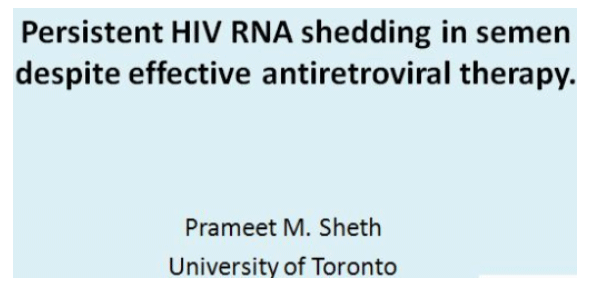
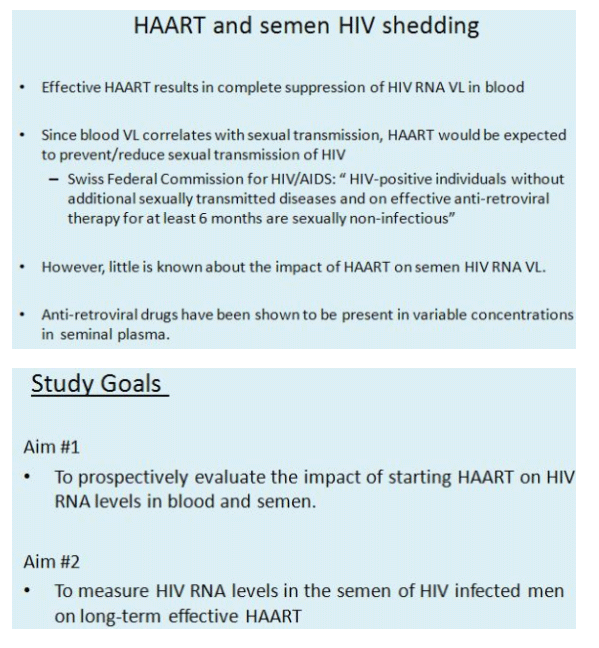
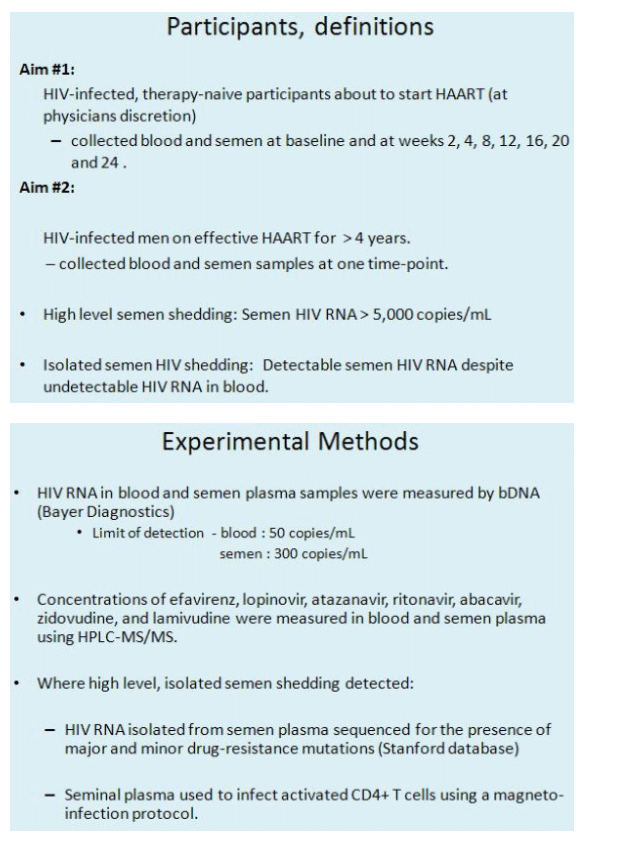
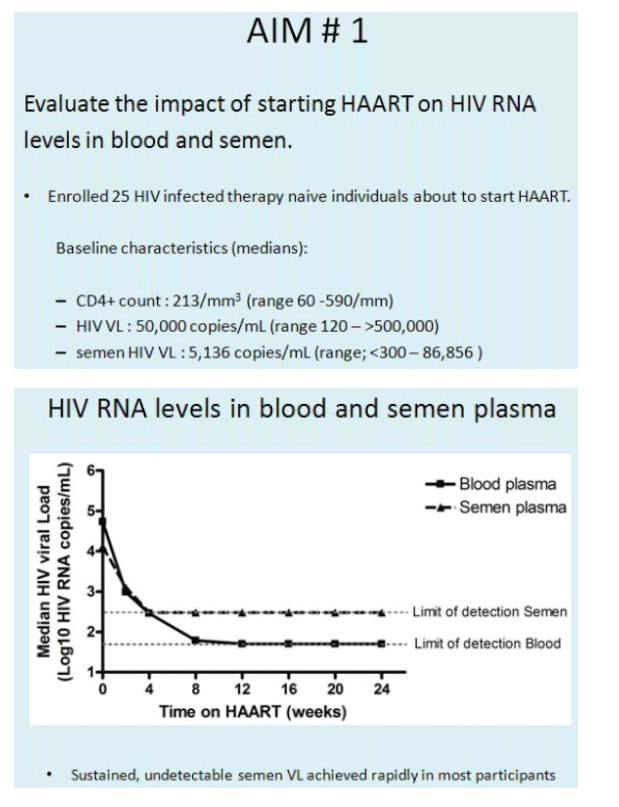
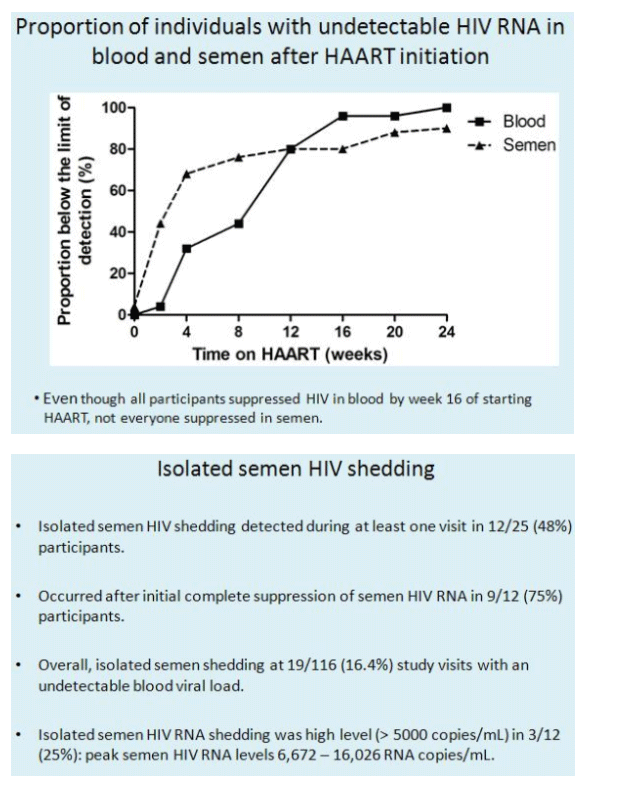
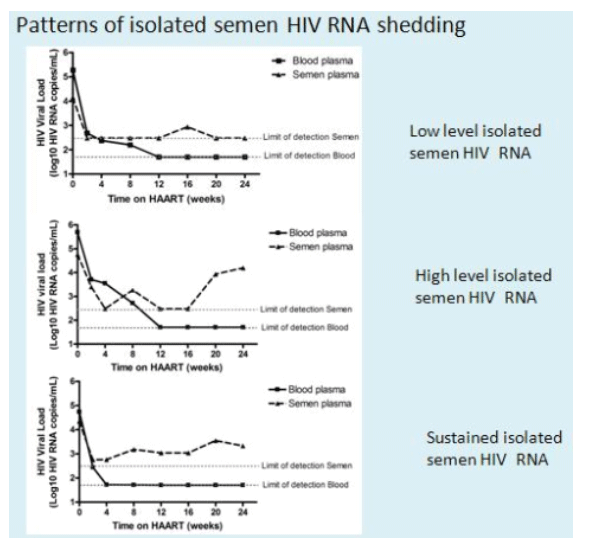
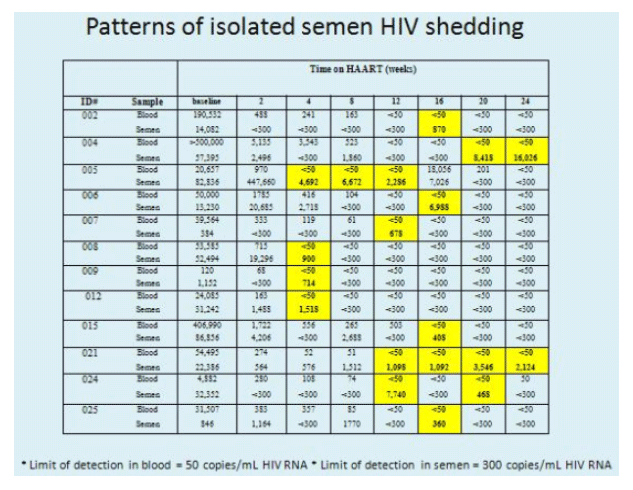
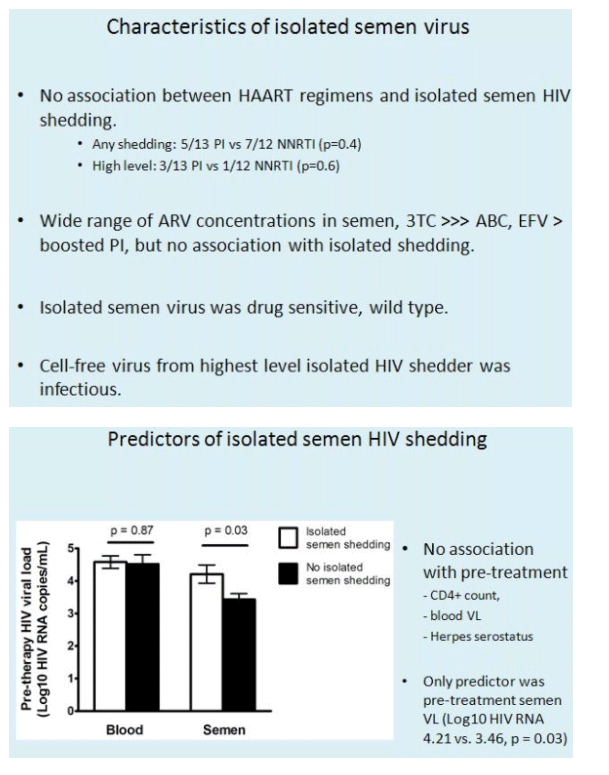
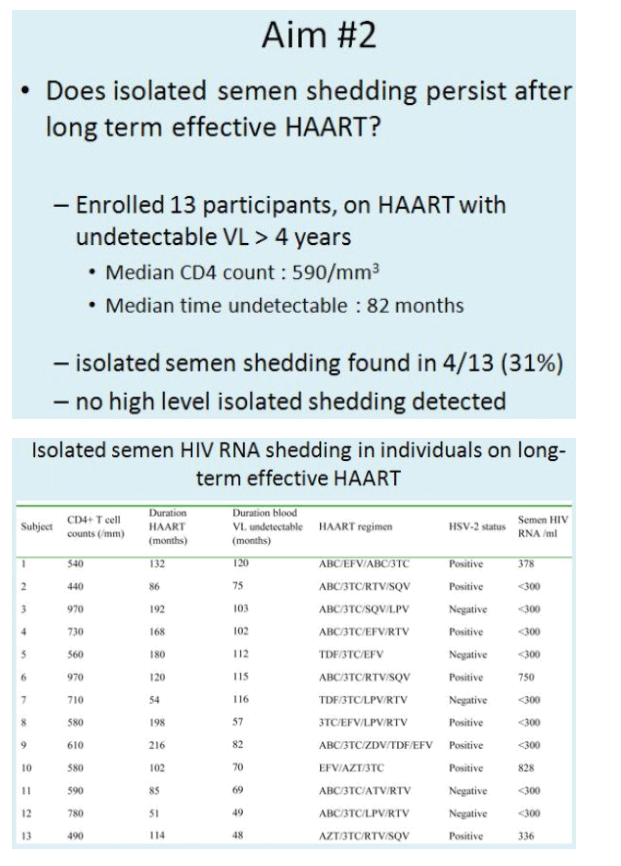
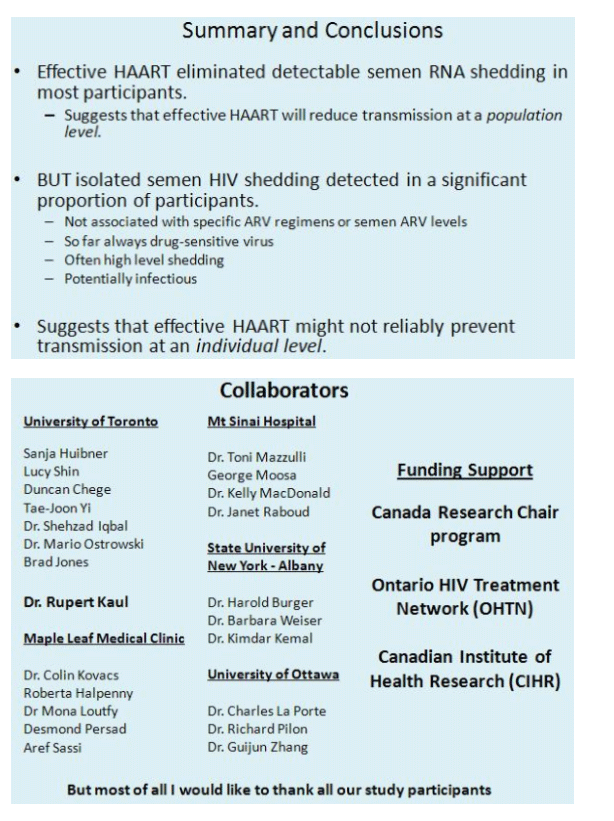
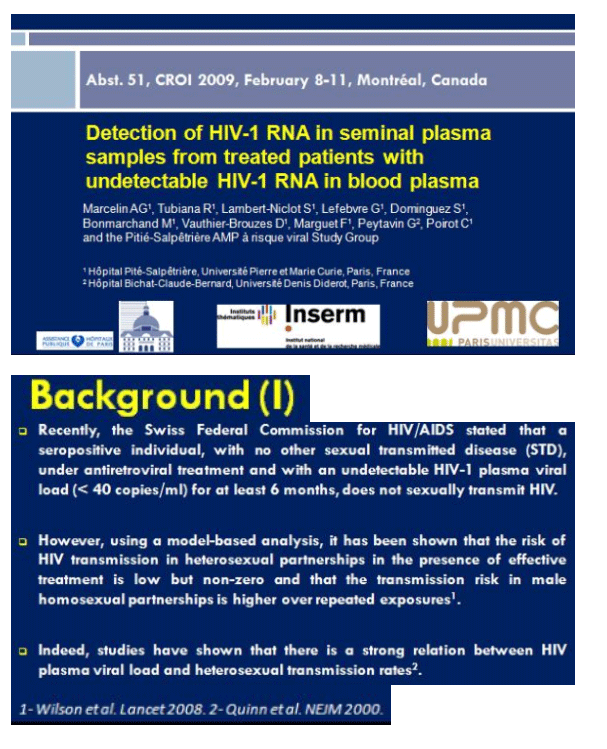
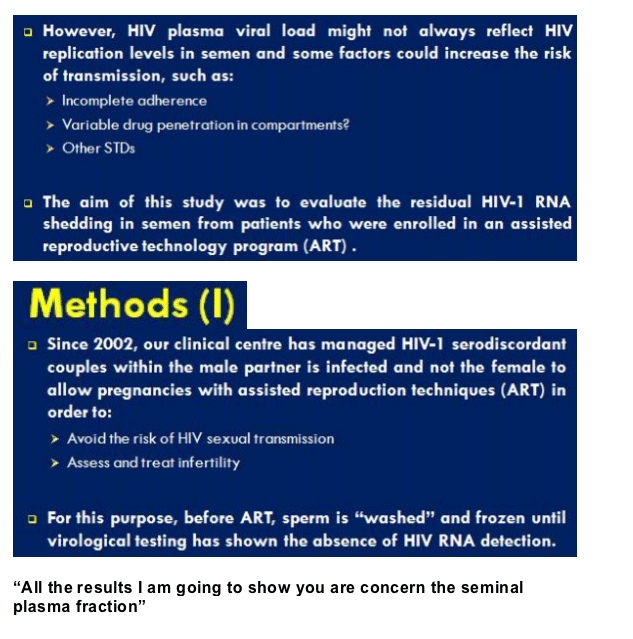
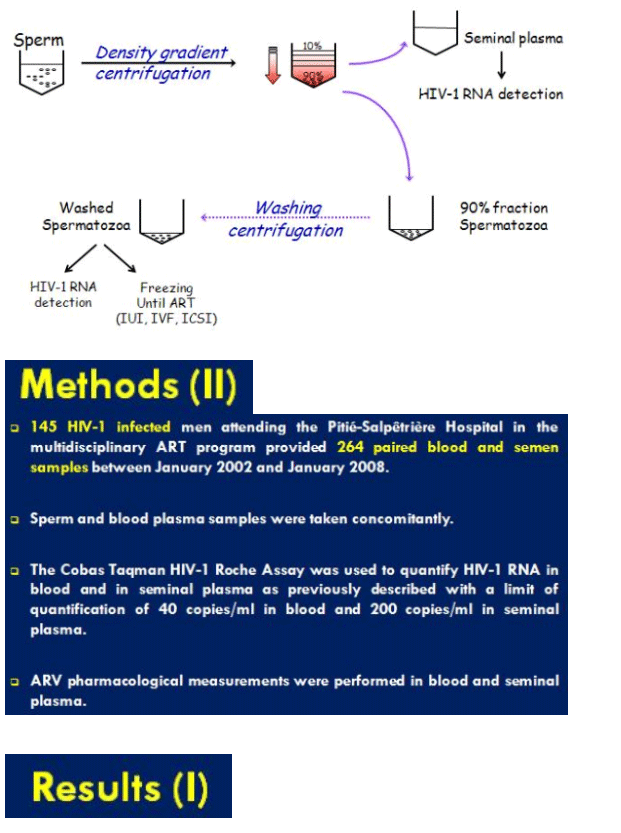
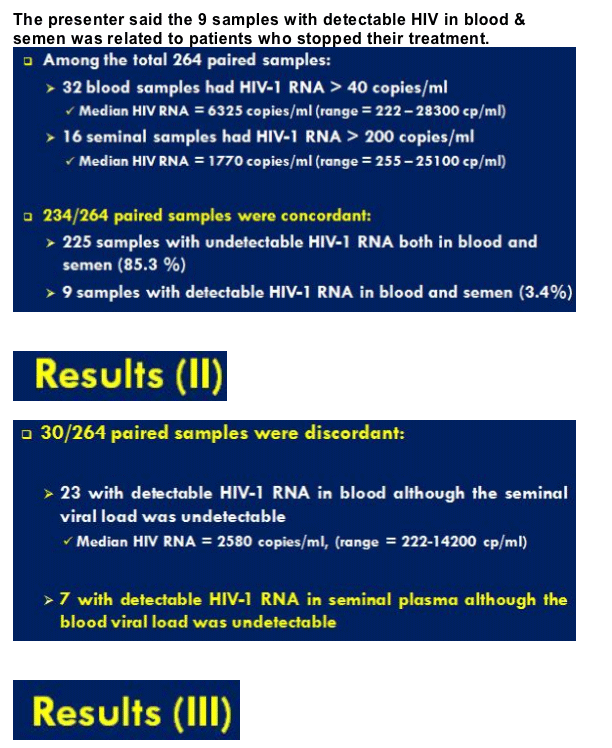
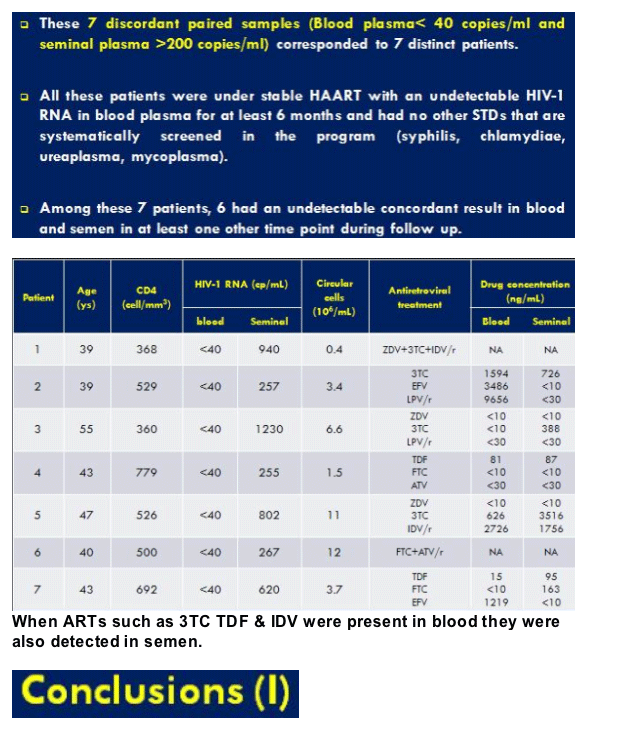
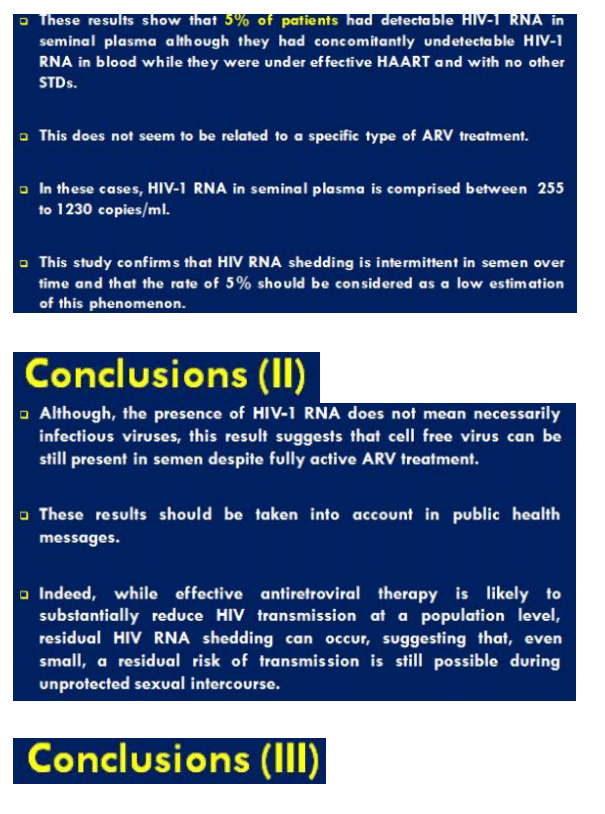

|
| |
|
 |
 |
|
|